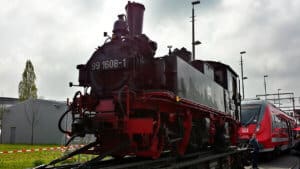As Saxon IV K (DR Class 99) a four-axle narrow gauge steam locomotive of the Royal Saxon State Railway was designated from 1900. The gauge of this locomotive is 750 mm. The Saxon IV K is the most-built, a total of 96 copies, narrow-gauge steam locomotive for a state railway in Germany. From 1925 the DR ordered the class 99.51-60 locomotives.
Details of Saxon IV K (DR Class 99)
| Manufacturer: | Sächsische Maschinenfabrik Chemnitz |
| Length: | 9000 mm |
| Numbering: | 99.51-60 |
| Weight: | 26.8-29.3 t |
| Years of construction: | 1892 - 1921 |
| Gauge: | 750 mm |
| Top speed: | 30 km/h |
| Fuel supply: | 0.85 t / 1.02 t ** hard coal |
| Water supply: | 2.4 m³ |
| Number: | 96 |
| Power: | 154 kW / 210 PSi |
| Brake: | Air brake |
| Boiler overpressure: | 12/14/15 bar |
| Grade: | K 44.7 / K 44.8 * |
| Type: | B'B' n4v |
* from 99 581; ** from 99 561
| Interesting facts |
|---|
| The steam locomotive DR Class 99 (Saxon IV K) belongs to the B'B' n4v type and has two driving axles coupled together in each of two different frame bogies. The locomotive is a wet steam four-cylinder compound locomotive. More interesting facts |
History and use of the steam locomotive Class 99

After the First World War 5 copies had to be written off and in 1918 one of the locos went to Serbia, where it remained after the end of the war. The four others had their mission for the Heeresbahnen which then remained in Transylvania, of which three came during the Second World War in Hungarian property. All machines used in the Baltic States during the First World War returned to Saxony before the end of the war.
In 1920, the German Reichsbahn took over the 90 remaining in Saxony locomotives. In 1925 the locomotives were given the numbers 99 511-546, 99 551-558, 99 561-579 and 99 581-608. In 1919, 15 five-axle Heeresfeldbahn locomotives were acquired, which were classified as Saxon genus IV K. Their replicas with the numbers 99.67-71 and the unit locomotives of the 99.73-76 were retired in the 1930s. Until 1939, another 18 machines were removed from the inventory and during the Second World War, another twelve were lost in war missions.
After World War II, two locomotives remained with the CSD, four were confiscated as Reperationsgut by the Soviet occupying power. The Deutsche Reichsbahn has 57 serviceable locomotives in its inventory. Nine locomotives came to Rügensche Kleinbahn and the former Prignitzer Kreiskleinbahnen, where they were equipped with Knorr brakes. In this context, they also received a conspicuous compressed air tank on the boiler. The Saxon IV K had its use on all Saxon narrow gauge lines and in the 1980s on the routes Selva-Jöhstadt, and Oschatz-Mügeln-Kemmlitz.
From 1932, 30 Saxon IV K were partly extensively renewed. Several locomotives received new welded boilers, but by 1967 a total of 23 locomotives also had new frames, bogies and cylinders. The completely newly built IV K can be seen on the square frame guide under the cab. The last not renewed steam locomotives separated until 1973 from the service. The still largely original locomotives 99 535 (Transport Museum Dresden), 99 579 (Museum Rittersgrün), 99 581 (in Kirchberg planned museum) and 99 604 (DGEG, today SSB Radebeul) were guaranteed as a museum conservation. The locomotive 99 581 was scrapped in June 1983 in Kirchberg. The suspension of the general repaired and large-scale locomotives began in the early 1970s. In mid-1991, there were still 13 Saxon IV K in the DR portfolio. As part of the merger of the DR and DB, these locomotives were to receive the new operating numbers 099 701 to 099 713 from 1 January 1992. Two locomotives were sold in 1991 to the museum railway Jöhstadt-Steinbach and the locomotive 99 562 was turned off. So only 10 copies were provided with the new numbers. Other locomotives divorced 1992/93 by the sale to the Döllnitzbahn GmbH. On January 1, 1994, several locomotives came to Deutsche Bahn AG, but was never used as planned.
Received Saxon IV K (DR Class 99) locomotives:
»99 516 Schönheide Museum Railway
»99 534 Memorial locomotive in Geyer
»99 535 Transport Museum Dresden
»99 539 (099 701-51) Traditionsbahn Radebeul
»99 542 (099 702-31) Preßnitztalbahn
»99 555 SOEG, property association of Zittauer Schmalspurbahnen e.V.
»99 561 (099 703-11) Förderverein Wilder Robert
»99 562 (099 704-91) German Steam Locomotive Museum, Neuenmarkt-Wirsberg
»99 564 (099 705-61) Saxon Steam Railway Company
»99 566 Saxon Railway Museum, Chemnitz
»99 568 IG Preßnitztalbahn
»99 574 (099 707-21) Döllnitzbahn (parked in autumn 2018)
»99 579 Narrow Gauge Railway Museum Rittersgrün
»99 582 (099 708-01) Schönheide Museum Railway
»99 584 (099 709-81) Döllnitzbahn (operational again since August 2018)
»99 585 (099 710-61) Schönheide Museum Railway
»99 586 (099 711-41) Traditionsbahn Radebeul
»99 590 IG Preßnitztalbahn
»99 594 IG Preßnitztalbahn, currently (as of August 2018) in Meiningen for main inspection
»99 604 Sächsische Schmalspurbahnen Foundation (ex association for the promotion of Saxon narrow-gauge railways e.V.) (Radebeul narrow-gauge railway museum)
»99 606 (099 712-21) Foundation Saxon Narrow Gauge Railways (ex Association for the Promotion of Saxon Narrow Gauge Railways e.V.) (as of 2018: deposited in the historic goods grounds in Radebeul East)
»99 608 (099 713-01) Saxon Steam Railway Company
1 service number at the DB
